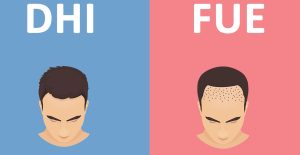FUE vs. DHI Hair Transplant: Which Technique is Right for You?
When considering a hair transplant, choosing the right technique is crucial to achieving natural-looking results. Two of the most popular methods today are FUE (Follicular Unit Extraction) and DHI (Direct Hair Implantation). Each offers unique benefits and considerations. In this article, we’ll dive into both techniques to help you decide which method is best for you.
What is FUE (Follicular Unit Extraction)?
FUE is a minimally invasive hair transplant technique where individual hair follicles are extracted from a donor area (usually the back or sides of the head) and transplanted into the thinning or balding areas. This method involves using a small punch tool to extract the follicles, which leaves minimal scarring and a quick recovery time.
Advantages of FUE:
- Minimal Scarring: The small puncture marks left behind are virtually invisible once healed.
- Quick Recovery: Most patients can return to normal activities within a few days.
- Versatility: Suitable for patients with a variety of hair types and degrees of hair loss.
Disadvantages of FUE:
- Longer Procedure Time: Depending on the number of grafts, the process may take several hours or even a full day.
- Requires Skilled Surgeons: Precision is key to avoid follicle damage, so it’s important to choose an experienced surgeon.
What is DHI (Direct Hair Implantation)?
DHI is an advanced form of FUE, offering similar extraction methods but with an additional step in implantation. Instead of creating incisions for follicle placement, the follicles are directly implanted using a special pen-like tool, known as a Choi implanter pen. This method allows for more precise control over the angle, depth, and direction of each hair follicle.
Advantages of DHI:
- More Precision: The Choi implanter allows for better placement and ensures a more natural hairline.
- Fewer Sessions Needed: The direct implantation technique may reduce the number of sessions required compared to FUE.
- Less Trauma to the Scalp: Because the hair follicles are implanted without the need for incisions, there’s less trauma to the scalp and, in some cases, a quicker recovery.
Disadvantages of DHI:
- More Expensive: The advanced tools and techniques involved in DHI often make it a more expensive option.
- Requires Highly Skilled Surgeons: The precision needed in DHI makes it even more crucial to choose an expert surgeon.
FUE vs. DHI Hair Transplant: Key Differences
| Feature | FUE | DHI |
|---|---|---|
| Extraction Method | Follicles are extracted using a punch tool. | Follicles are extracted and implanted using a Choi implanter. |
| Implantation | Incisions are made to place the follicles. | Follicles are directly implanted without incisions. |
| Recovery Time | Short recovery time, minimal scarring. | Faster recovery with less scalp trauma. |
| Precision | Good precision, but the surgeon creates incisions. | More precise placement with the Choi pen. |
| Suitability | Suitable for most hair types and stages of hair loss. | Ideal for those looking for a more natural hairline and denser coverage. |
Which Hair Transplant Method is Right for You?
Choosing between FUE and DHI depends on several factors, including your hair loss severity, budget, and desired outcome. Here’s a guide to help you decide:
- If you want a cost-effective option with a proven track record, FUE is a great choice. It’s widely available and works well for most candidates.
- If you’re seeking a more precise, natural look with faster recovery, DHI may be the ideal technique for you, especially if you have a higher budget.
Both methods are highly effective and lead to successful outcomes, but FUE may be more suitable for those with moderate hair loss or looking for a more affordable option, while DHI is perfect for those wanting maximum precision and faster results.
Conclusion:
Both FUE vs. DHI have distinct advantages, and the best hair transplant method for you depends on your specific needs. To ensure the best results, it’s essential to consult with a professional who can guide you through the decision-making process. Whether you choose FUE for its affordability and versatility or DHI for its precision and natural results, both methods can help restore your hair and confidence.
Ready to take the next step toward a fuller, more confident you? Contact us today to learn more about FUE and DHI hair transplants and book your consultation with one of our expert surgeons.



